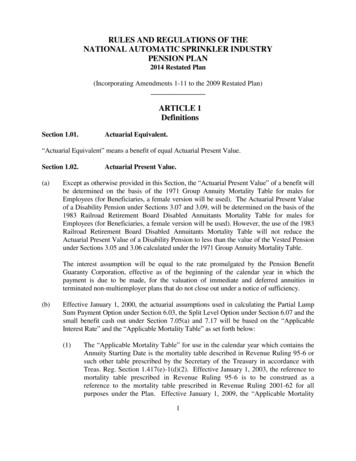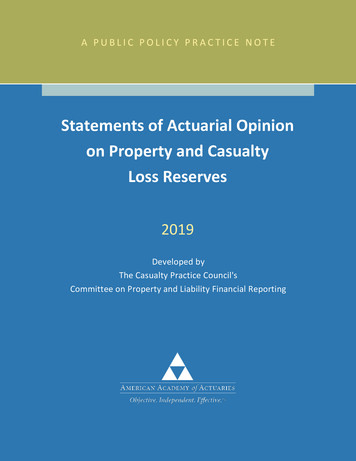
Transcription
R for Actuarial Science StudentsArun MadappatDiyana Najwa Nor AzmiJimmy HuangMentor: David VarodayanSupported by the Society of Actuaries (SoA) Center of ActuarialExcellence (CAE) Grant1
Table of ContentsChapter 1:Basics of R & R in Actuarial ScienceChapter 1.1: Data AnalysisChapter 1.2: Stats PackageChapter 1.3: TVM PackageChapter 2: Lifecontingencies PackageChapter 2.1: Inputting Life TableChapter 2.2: Basic Life Contingency FunctionsChapter 2.3: Miscellaneous FunctionsChapter 2.4: SOA Illustrative LifetableChapter 2.5: Miscellaneous FunctionsChapter 2.6: Other Country’s LifetablesChapter 2.7: Creating an Actuarial TableChapter 2.8: Increasing and Decreasing Life InsurancesChapter 2.9: Annuities Immediate and DueChapter 2.10: ConclusionChapter 3: R in Financial EconomicsChapter 3.1: Put Call ParityChapter 3.2: American Call OptionChapter 3.3: European Call OptionChapter 3.4: American Option and European OptionChapter 3.5: Black Scholes ModelChapter 3.6: Cox, Ross, and Rubinstein Binomial ModelChapter 3.7: Conclusion2
Chapter 1:Basics of R & R in Actuarial ScienceThis chapter will focus on three of the many uses of R: data analysis, basic statisticalcalculations, as well as concepts dealing with the time value of money. All of these uses arehighly relevant to those involved in the actuarial field. Being able to take a set of data anddraw meaningful conclusions from it is an essential tool for an actuary to have. Calculatingand understanding basic statistical derivations is also highly useful in the field of actuarialscience. Finally, understanding the concepts surrounding the time value of money is not onlyuseful for the FM exam, but also for working in the actuarial field.Chapter 1.1: Data AnalysisOne of the most basic tools we can use for analyzing a set of data is calculating the expectedvalue, which is the long run average for a set of data or formula.To calculate the expected value E(x) of a dice roll, create the vector x with the possible valuesfor the dice roll and the vector y for the corresponding probabilities of those values. Then, takethe sum of the product of the two vectors: x -c(1,2,3,4,5,6) y -c((1/6),(1/6),(1/6),(1/6),(1/6),(1/6)) sum(x*y)[1] 3.5For the expected value of any discrete probability function make a vector for x and f(x), thentake the sum of the product of the 2 vectorsCalculate E(x2) for a dice roll3
x -c(1:6) y -c((1/6),(1/6),(1/6),(1/6),(1/6),(1/6)) sum((x 2)*y)[1] 15.16667For E(x2) of any discrete probability function make a vector for x and f(x), then take the sum ofthe product x2*yEasy visualizations with R:plot the PDF for a dice roll x -c(1:6) y -c((1/6),(1/6),(1/6),(1/6),(1/6),(1/6)) plot(x,y)More advanced data sets:You can load in your own data set into Rstudio quite easily, tutorial here:https://www.youtube.com/watch?v I1K3ZijJ3LMFortunately, R has a series of data sets preloaded into R for us to learn with. You can viewthem by typing data() into the console like so:4
data()For the sake of this tutorial we will use the AirPassengers dataset which analyzes the numberof air passengers by month from the year 1949 to 1960This data set can be accessed by simply typing AirPassengers, AirPassengersJan Feb Mar Apr May Jun Jul Aug Sep Oct Nov Dec1949 112 118 132 129 121 135 148 148 136 119 104 1181950 115 126 141 135 125 149 170 170 158 133 114 1401951 145 150 178 163 172 178 199 199 184 162 146 1661952 171 180 193 181 183 218 230 242 209 191 172 1941953 196 196 236 235 229 243 264 272 237 211 180 2011954 204 188 235 227 234 264 302 293 259 229 203 2291955 242 233 267 269 270 315 364 347 312 274 237 2781956 284 277 317 313 318 374 413 405 355 306 271 3061957 315 301 356 348 355 422 465 467 404 347 305 3361958 340 318 362 348 363 435 491 505 404 359 310 3371959 360 342 406 396 420 472 548 559 463 407 362 4051960 417 391 419 461 472 535 622 606 508 461 390 432A quick analyses of your data can be done using the summary function like so: summary(AirPassengers)Min. 1st Qu. MedianMean 3rd Qu.Max.104.0 180.0 265.5 280.3 360.5 622.05
A more advanced analyses can be done using the psych package which can be installedusing the following command: install.packages("psych")Then simply load the package using the library command: library(psych)And finally use the following command to find a more meaningful analyses of your data describe(AirPassengers)vars n mean1sd median trimmedmad min max range1 144 280.3 119.97 265.5 271.45 133.43 104 622 518skew kurtosis se1 0.57-0.43 10In order to graph this, we need to change this data frame into a matrix using the followingcommand apm - matrix(AirPassengers, ncol 12, byrow TRUE, dimnames list(as.character(1949:1960),month.abb))We can then make meaningful graphs such as air passengers vs year using6
plot(AirPassengers)Chapter 1.2: Stats PackageNow that you’ve learned the basics of data analysis in R, it is time to learn about theeffectiveness of the Stats package in solving many of the tedious calculations found in examP.First, let’s learn how to calculate the variance of a vector with given data values. var(1:10)[1] 9.166667This code calculates the variance between a vector filled of values from 1 through 10.7
Why is this code useful?Quickly calculates the variance from a given vector of valuesWhat does this code do?Takes the given values and calculates the variance using the formulaWhat does the result mean?It is variance of the given vector values, how spread out the values are.x c(1,2,3,4,5)assigns vector of 1 2 3 4 5 to xy c(2,4,6,8,10)assigns vector of 2 4 6 8 10 to yWe can also find the covariance of 2 vectors using the cov functionExample: cov(x,y)[1] 5Why is this code useful?Quickly calculates the covariance between vectors x and yWhat does this code do?Takes the given vector values for x and y and calculates the covariance using the formulaE(xy) E(x)E(y)What does the result mean?Covariance is a measure of the strength of the correlation between vectors x and yTo find the standard deviation of a given vector, we can either take the square root of thevariance or use the sd function. In this example we will use the same vector y as above.Example:8
sd(y)[1] 3.162278Why is this code useful?Quickly calculates the standard deviation of vector yWhat does this code do?Takes the given vector values y and calculates the standard deviation using the formulaWhat does the result mean?Standard Deviation is another measure of the spread of the values around the meanWe can also find the correlation coefficient between 2 vectors using the cor function as below.We will be using the same vector x as above.Example: y c(2,5,6,4,88) cor(x,y)[1] 0.72132Why is this code useful?Quickly finds the correlation coefficient between x and the new vector yWhat does this code do?Takes the given vector values for x and y and calculates the correlation using the formula(Cov(x,y))/(std(x)*std(y))What does the result mean?Correlation describes how x and y are related. correlation coefficient of greater than 0 meansx and y are directly related, less than 0 means inversely related, and 0 means not related.These are some of the basic uses of the stats package that will help you to save some timewhen calculating these simple, but sometimes tedious calculations. To learn more about thevarious uses of the stats package visit the link below:http://stat.ethz.ch/R manual/R patched/library/stats/html/00Index.html9
Chapter 1.3: TVM PackageNow that you have learned some of the topics found in exam P and the basics of R, itis time to learn about how to master the Time Value of Money(TVM) package. This packagedeals with many of the concepts found in exam FM and can save time by solving complicatedtime value of money problems at the click of a mouse.We will first discuss the cashflow function which can return the cashflows of a loan given theinterest rate, maturity, loan amount and type.How to use it:cashflow(loan)Example:cashflow(loan(rate 0.07, maturity 30, amt 1000, type "bullet"))[1] 70 70 70 70 70 70 70 70 70 70 70 70 70 70 70[16] 70 70 70 70 70 70 70 70 70 70 70 70 70 70 1070Why is this code useful?Quickly calculates the cashflows of a given loanWhat does this code do?Takes the given input values for the loan and creates a series of cashflows that describe theloan with these input valuesWhat does the result mean?These values represent all the payments to be made throughout the entire repayment of theloan. A bullet loan means all the principal is paid back on the last payment while all otherpayments represent interest on the loan.Now, let’s look at the cft function which can calculate the total financial cost of a loan, giventhe loan amount, maturity, interest rate, the fee the loan payer pays upfront, as well as the feethe loan payer pays per payment period.How to use it:cft(amt, maturity, rate, up fee 0, per fee 0)Example:cft(amt 100, maturity 10, rate 0.05, up fee 1, per fee 0.1)[1] 0.0536347310
rate:effective interest rate, up fee:fee that a loan taker takes at the beginning of the loan,per fee:fee that the loan payer pays every periodWhy is this code useful?Quickly calculates the total financial cost of the loan including fees as well as interestWhat does this code do?Takes the given interest and fee values and determines the total financial cost of the loan.What does the result mean?The result represents the actual financial cost of the loan (interest fees)Another useful function TVM has to offer is the find rate function which finds the effective rateof interest on a loan given a vector of discount factors.How to use it:find rate(m, d, loan type), m maturity,d discount factor vectorExample: find rate(m 3, d c(0.99, 0.98, 0.97), loan type "bullet")[1] 0.01020408Why is this code useful?Quickly calculates the effective interest rate being paid given a vector of discount factorsWhat does this code do?Takes the discount values, loan type, and length to maturity and calculates the effective rateof interest being paid on the loan.What does the result mean?It is the effective rate of interest being paid on a loan that is being charged on a discountbasis.With TVM, you can also find the net present value of a series of cashflows given the interestrate, the amount of the cashflows, and when the cashflows are made.How to use it:Function: NPV (Net Present Value)Example npv(i 0.01, cf c(-1, 0.5, 0.9), ts c(0, 1, 3))[1] 0.3685806This code finds the net present value of cashflows of 1, 0.5, and 0.9 at times 0, 1, and 3respectively at an interest rate of 1%11
Why is this code useful?Quickly calculates the Net Present Value of a series of cashflows at a given time at a giveninterest rate.What does this code do?Takes the given cashflows and discounts them at the effective interest rate over the timebetween the cashflow and the present.What does the result mean?The value represents the present value of all cash inflows and outflows summed together.Using the pmt function, you can also find the payment amount that is necessary to cover theloan with a given interest rate and number of payment periods.How to use it:Function:PMT (Payment)Example: pmt(amt 100, maturity 10, rate 0.05)[1] 12.95046This code finds the payment for a 100 loan with 10 payments with a 5% interest ratebetween payments.Why is this code useful?Quickly calculates the scheduled payment for a loan with a given amount, interest rate, andterm to maturity.What does this code do?Takes the given input values and calculates a payment to pay off the loan at the term tomaturity while accounting for the given interest rate.What does the result mean?It is the scheduled payment that you would have to pay in order to pay off the loan by the termto maturity.You can also find the interest rate on a loan given the number of payments, payment amountand loan amount using the rate function.How to use it:rate(loan amount, maturity, payment)Example:12
rate(amt 100, maturity 10, pmt 15)[1] 0.08144239This finds the interest rate on a 100 loan with 10 payments of 15.Why is this code useful?Quickly calculates the effective rate of interest on a loanWhat does this code do?Takes the given loan amount, term to maturity, and amount of payment and calculates theeffective rate of interest that ensures that the loan is paid off in full at the last payment date.What does the result mean?The result represents the effective rate of interest being paid on a loan with these inputvalues.Now, with this guide you have been taught the absolute basics of data analysis, using thestats package, and understanding the concepts related to the time value of money using R.There is so much more you can learn with R in these topics or in any other topic that mayinterest you. Here are some links to learn more about these topics, as well as some of theother topics that R is useful for.actuar Package with lots of actuarial science functionality:http://cran.r project.org/web/packages/actuar/actuar.pdfA comprehensive guide to data analysis with R:http://cran.r project.org/doc/contrib/usingR.pdfR tutorial that covers more comprehensive statistical usages of R as well as programmingwithin R:http://www.cyclismo.org/tutorial/R/13
Chapter 2: Lifecontingencies PackageThis chapter mainly covers the lifecontingencies package, which has many of theintroductory functions that are used in the MLC or LC exams. It also contains variouslifetables for countries such as France, Italy, the United States, and the SOA illustrativelifetable. This is relevant to actuarial science as it has some of the foundations for the MLCand LC exams. It makes it easier to work through extensive calculations on a lifetable as youcan just have the machine calculate it. We will go through topics including:Inputting lifetable2.1 Basic Annuities2.2 Basic Life Contingencies Functions2.3 Miscellaneous Functions2.4 SOA Illustrative Lifetable2.5 Example Problem2.6 Other Country’s Lifetables2.7 Creating an Actuarial Table2.8 Increasing and Decreasing Life Insurances2.9 Annuities Immediate and Due2.10 Conclusion14
Chapter 2.1: Inputting Life TableOne of the most fundamental functions of the lifecontingencies package is inputting a life tableinto R. There are two main classes that have been defined in this particular package, whichare shown below. The actuarialtable is defined from the lifetable, but with the addition ofinterest. To get an even more detailed description of these two, the “showMethods” functionoffers more information.Example showClass("lifetable")Class "lifetable" [package "lifecontingencies"]Slots:Name:xlxnameClass: numeric numeric characterKnown Subclasses: "actuarialtable" showClass("actuarialtable")Class "actuarialtable" [package "lifecontingencies"]Slots:Name: interestxlxnameClass: numeric numeric numeric characterExtends: "lifetable"15
In order to input the actual values of the lifetable into R, we use the following code as anexample:Example x sample -seq(from 0, to 9, by 1) lx sample -c(900, 800, 700, 600, 500, 400, 300, 200, 100, 0) lifetable -new("lifetable", x x sample, lx lx sample, name "lifetable")removing NA and 0s print(lifetable)Life table 0200100px 51.00.50.01. Why is this code useful?This code allows you to input data into a lifetable, which will then allow you to perform avariety of other calculations. It also provides a check in that it won’t allow you to input a valueof lx that’s higher than before because the probability of survival must decrease after eachyear and the values of x and lx must match.2. What does the code do?The first line of code creates the x values from 0 to 9 by 1’s. The second line of code assignsthe values of how many people are alive at each corresponding x term. This is labelled lx. Thethird line of code creates a lifetable titled, “lifetable” and generates the rest of the table seen.The print line just prints these results into the table shown at the bottom and outputs them.3. What does the result mean?This creates a life table where x is the year and lx is how many people out of 900 survive atthat time in this case. Ex is the number of years they’re expected to survive at that point intime and px is the probability they’ll survive one year at age x.16
Chapter 2.2: Basic Life Contingency FunctionsAfter we’ve inputted a lifetable into R, we can begin to use the numbers in the table to runfunctions. Shown here are some of the most basic functions:Example DemoEX1 pxt(lifetable, 5,1) c(DemoEX1)[1] 0.75 DemoEX2 qxt(lifetable, 5, 1) c(DemoEX2)[1] 0.25 DemoEX3 exn(lifetable, 5, 1, "complete") c(DemoEX3)[1] 0.875 DemoEX4 mxt(lifetable, 5, 1) c(DemoEX4)[1] 0.28571431. Why is this code useful?This table makes use of any lifetable you might’ve created and performs the basic lifecontingencies functions on it.2. What does the code do?The first line of code references the lifetable called, “lifetable” and puts it into a variable called,“DemoEX1”. This specific example calculates 1p5 and the second line prints the value thisgenerates. The variable called “Demo EX2” calculate 1q5, which is just 1 1p5 and “DemoEX3” calculates the expected lifetime between times 1 and 5, which is e angle 5:1. “DemoEX4” calculates 1m5, which is the average death rate experienced by the initial lives over theperiod 5 to 6 in this case.3. What does the result mean?This uses the data from the lifetable just generated. The first one calculates 1p5, the secondone calculates 1q5, and the third one calculates e5:1 and the last one finds 1m5.17
Chapter 2.3: Miscellaneous FunctionsThis is an example of another function possible through the lifecontingencies package.Specifically, the first block of code just calls upon the first lifetable we generated in chapter2.1, then we create another lifetable and call upon the same functions to confirm the validity ofthe head and tail functions.Example head(lifetable)x lx1 0 9002 1 8003 2 7004 3 6005 4 5006 5 400 tail(lifetable)x lx5 4 5006 5 4007 6 3008 7 2009 8 10010 9 0 summary(lifetable)This is lifetable: lifetableOmega age is: 9Expected curtated lifetime at birth is: 4 x sample seq(from 0, to 15, by 1) lx sample c(1500, 1400, 1300, 1200, 1100, 1000, 900, 800, 700, 600, 500, 400, 300, 200,100, 0) lifetable new("lifetable", x x sample, lx lx sample, name "lifetable")removing NA and 0s print(lifetable)Life table lifetable1234x lxpx ex0 1500 0.9333333 7.01 1400 0.9285714 6.52 1300 0.9230769 6.03 1200 0.9166667 5.518
5 4 1100 0.9090909 5.06 5 1000 0.9000000 4.57 6 900 0.8888889 4.08 7 800 0.8750000 3.59 8 700 0.8571429 3.010 9 600 0.8333333 2.511 10 500 0.8000000 2.012 11 400 0.7500000 1.513 12 300 0.6666667 1.014 13 200 0.5000000 0.515 14 100 0.0000000 0.0 head(lifetable)x lx1 0 15002 1 14003 2 13004 3 12005 4 11006 5 1000 tail(lifetable)x lx11 10 50012 11 40013 12 30014 13 20015 14 10016 15 0Why is it useful?The head and tail function invoke the first 6 values of the lifetable and the last 6 values of itrespectively. If for some reason you needed just those values this function would do it for you.What does the code do?The head function takes the first 6 values of x and lx that you inputted and prints them and thetail function takes the last 6 values of x and lx that you printed and prints them. If there aren’t6 values total, then it just prints all of them as seen in the last life table I made.The summary function gives you the limiting age, which is the longest anyone can survive andthe expected curtate lifetime at birth.What does the result mean?This result gives you the first 6 values and the last 6 values through the head and tailfunctions and how long someone can survive and expected curtate lifetime at birth with thesummary function on a specific lifetable.19
Chapter 2.4: SOA Illustrative LifetableOne of the more important and commonly referenced lifetables, especially while workingthrough practice problems is the SOA illustative lifetable. Luckily, instead of having to inputthe entire thing, it is possible to just call upon it as all the values have already been inputtedas shown below:Example data("soa08Act") pxtLin pxt(soa08Act, 80, 0.5, "linear") c(pxtLin)[1] 0.9598496 pxtLin pxt(soa08Act, 80, 0.5, "linear") c(pxtLin)[1] 0.9598496 pxtConst pxt(soa08Act, 80, 0.5, "constant force") c(pxtConst)[1] 0.95900941. Why is this code useful?This code makes use of a previously created lifetable called soa08Act and it gives a moreadvanced function which allows for calculations of fractional survival probabilities. Soa08Act isthe SOA illustrative life table at 6% interest.2. What does the code do?The first line calls for the dataset of the soa08Act and the second line calculates 0.5p80 andthis is calculation through linear interpolation. This value is printed in the 3rd line. The nextblock of code calculates 0.5p80 through a constant force of mortality and prints it.3. What does the result mean?The first result is the calculation of 0.5p80 through linear interpolation and the second resultsis the calculation of 0.5p80 through a constant force of mortality based on the SOA lifetable at6%.20
Chapter 2.5: Miscellaneous FunctionsThis is a basic example problem that could confirm some of the various uses of the functionsthat we have worked through to this point.Table 3.1 gives an extract from a life table. Calculate 5p0, q5, 5q0 and how many people diedbetween time 0 and 3Example x problem seq(from 0, to 9, by 1) lx sample c(10000, 9965.22, 9927.12, 9885.35, 9839.55, 9789.29, 9734.12, 9673.56,9607.07, 9534.08) lifetable new("lifetable",x x problem, lx lx sample, name "lifetable") print(lifetable)Life table lifetablexlxpxex1 0 10000.00 0.9965220 8.79553602 1 9965.22 0.9961767 7.82623363 2 9927.12 0.9957923 6.85627054 3 9885.35 0.9953669 5.88524135 4 9839.55 0.9948920 4.91263526 5 9789.29 0.9943642 3.93785767 6 9734.12 0.9937786 2.96017628 7 9673.56 0.9931266 1.97870799 8 9607.07 0.9924025 0.9924025 problem1 pxt(lifetable,0,5) c(problem1)[1] 0.978929 problem2 qxt(lifetable,5,1) c(problem2)[1] 0.005635751 problem3 qxt(lifetable, 0, 5) c(problem3)[1] 0.021071Just to confirm that this follows the rules of a life table: sum problem1 problem321
c(sum)[1] 1 problem4 dxt(lifetable, 0,3) c(problem4)[1] 114.65For people age 3, this is how many years they’re expected to live out of the next 2 curtate exn(lifetable,3,2) c(curtate)[1] 1.9856491. Why is this code useful?This is an example problem that was introduced relatively early on in the MLC class. Thiscode inputs the lifetable into R and calculates everything the problem asks for. This showsthat while it may be some trouble learning these functions, it can make doing multiplecalculations much easier.2. What does the code do?The first section inputs this lifetable that we’re given into R as shown before. The secondsection calculates 5p0 and prints it, the third block calculates 1q5 and the fourth calculates5q0. The next section is a reasonability check to make sure that 5p0 and 5q0 sum to be 1 andthe section called problem 4 calculates how many people died from times 0 to 3.3. What does the result mean?This result just tells us what the problem asked and it’s kind of a culmination of the things thathave been shown so far but with more realistic numbers.22
Chapter 2.6: Other Country’s LifetablesHere is some of the basic information for actual lifetables that can be referenced. Thisparticular one uses the USA lifetable, but there is data for other countries, as mentionedbelow.Example data("demoUsa") usaMale07 demoUsa[,c("age", "USSS2007M")] names(usaMale07) c("x","lx") usaMale07Lt as(usaMale07,"lifetable") usaMale07Lt@name "USA MALES 2007" c(usaMale07) x[1] 0 1 2 3 4 5 6 7 8 9 10 11 12 13 14 15 16 17 18 19 20 21 22 23 2425 26 27 28 29 30 31 32 33 34 35 36 37 38 39 40 41 42 43 44 45 46 47 48[50] 49 50 51 52 53 54 55 56 57 58 59 60 61 62 63 64 65 66 67 68 69 70 7172 73 74 75 76 77 78 79 80 81 82 83 84 85 86 87 88 89 90 91 92 93 94 95 9697[99] 98 99 100 101 102 103 104 105 106 107 108 109 110 111 112 113 lx[1] 100000 99262 99213 99182 99158 99138 99120 99104 99089 99075 9906599056 99047 99032 99007 98968 98912 98841 98754 98654 98541 98414 9827598128 97980 97834 97693 97555[29] 97419 97284 97147 97009 96868 96724 96576 96423 96264 96096 9591995729 95525 95303 95062 94800 94517 94209 93875 93513 93120 92691 9222491716 91165 90572 89940 89270[57] 88558 87800 86995 86138 85227 84254 83217 82111 80935 79684 7835176929 75411 73792 72066 70223 68254 66161 63947 61612 59147 56545 5381150951 47974 44882 41683 38401[85] 35063 31699 28341 25024 21785 18670 15722 12986 10501 8297 6393 47943496 2479 1711 1149 754 481 298 179 104 58 31 168421[113] NA NA1.Why is this code useful?You can also reference premade USA, Italian and Chinese lifetables for the data. The x isthe age and the lx is how many people out of 100,000 would be alive in the United States.This might be useful if you wanted real life data about some topics to get a reasonabilitycheck on actual numbers. The table is formatted the same way it’s just shown differently whenprinted and it caps out at 113 for the USA’s.23
2.What does the code do?It shows the age of males in the USA in the year 2007 then prints the datatable.3.What does the result mean?This result shows how many many males in the US are expected to survive at each age with100000 starting out at time 0. There are also datasets for the UK, China, Italy, Japan, Franceand Canada.24
Chapter 2.7: Creating an Actuarial TableThis code creates an actuarial table that gives more output and allows you to input an interestrate as well.Example x sample seq(from 0, to 15, by 1) lx sample c(1500, 1400, 1300, 1200, 1100, 1000, 900, 800, 700, 600, 500, 400, 300, 200,100, 0) lifetable new("lifetable", x x sample, lx lx sample, name "lifetable")removing NA and 0s exampleAct new("actuarialtable", x x sample, lx lx sample, interest 0.03, name "example actuarialtable")removing NA and 0s c(exampleAct)[[1]]Actuarial table example actuarialtable interest rate 3 %x lxDxNxCxMxRx1 0 1500 1500.00000 10513.08954 97.08738 1193.79351 8893.813092 1 1400 1359.22330 9013.08954 94.25959 1096.70613 7700.019593 2 1300 1225.37468 7653.86623 91.51417 1002.44654 6603.313464 3 1200 1098.16999 6428.49155 88.84870 910.93237 5600.866925 4 1100 977.33575 5330.32156 86.26088 822.08367 4689.934546 5 1000 862.60878 4352.98581 83.74843 735.82279 3867.850887 6 900 753.73583 3490.37702 81.30915 652.07436 3132.028098 7 800 650.47321 2736.64119 78.94092 570.76521 2479.953729 8 700 552.58646 2086.16798 76.64167 491.82429 1909.1885110 9 600 459.85004 1533.58152 74.40939 415.18262 1417.3642211 10 500 372.04696 1073.73148 72.24213 340.77323 1002.1816012 11 400 288.96851 701.68452 70.13799 268.53110 661.4083813 12 300 210.41396 412.71601 68.09513 198.39311 392.8772814 13 200 136.19027 202.30205 66.11178 130.29798 194.4841715 14 100 66.11178 66.11178 64.18619 64.18619 64.1861916 15 0 0.00000 0.00000 0.00000 0.00000 0.00000Why is this code useful?This particular code creates an actuarialtable which is much more detailed than a lifetable. Itcalculates everything based on 3% interest and it just uses the same code from the lifetable.What does this code do?25
The first few lines just input the same data into the actuarialtable as before and the next linescreate the table with 3% interest calling it example actuarialtable and putting it into thevariable “exampleAct”, then prints it.What does the result mean?This prints out the information from the lifetable and the classical commutation functions.More information about these functions can be found on the bottom of page 29 from this link:http://cran.r es/an introduction to lifecontingencies package.pdf26
Chapter 2.8: Increasing and Decreasing Life InsurancesThis code once again references a lifetable and performs slightly more advanced functions onit in the form of the increasing and decrease life insurances.Example x sample seq(from 0, to 15, by 1) lx sample c(1500, 1400, 1300, 1200, 1100, 1000, 900, 800, 700, 600, 500, 400, 300, 200,100, 0) lifetable new("lifetable", x x sample, lx lx sample, name "lifetable")removing NA and 0s print(lifetable)Life table lifetablex lxpx ex1 0 1500 0.9333333 7.02 1 1400 0.9285714 6.53 2 1300 0.9230769 6.04 3 1200 0.9166667 5.55 4 1100 0.9090909 5.06 5 1000 0.9000000 4.57 6 900 0.8888889 4.08 7 800 0.8750000 3.59 8 700 0.8571429 3.010 9 600 0.8333333 2.511 10 500 0.8000000 2.012 11 400 0.7500000 1.513 12 300 0.6666667 1.014 13 200 0.5000000 0.515 14 100 0.0000000 0.0 DemoEX6 IAxn(lifetable, 5, 1, 6) c(DemoEX6)[1] 0.01428571 DemoEX7 DAxn(lifetable, 5, 1, 6) c(DemoEX7)[1] 0.01428571Why is this code useful?This is a slightly more complex function of increasing and decreasing life insurances.What does this code do?27
It first creates another lifetable, then assigns the increase and decreasing life insurances tothe variables DemoEX6 and DemoEX7. The first field asks for the name of the lifetable youwant to use and the second is the x value.The third is the n value and the fourth is the interestrate. You can also put in values for m, k, EV and power if required.What does the result mean?It simply outputs the values of these functions based on the lifetable and the values I put intothe fields.28
Chapter 2.9: Annuities Immediate and DueThis code simply calculates the values of increasing and decreasing annuities both due andimmediate as show below:Example 100*annuity(i 0.05, n 6)[1] 507.5692 100*accumulatedValue(i 0.05, n 6)[1] 680.1913 iannuity -annuity(i 0.03, n 5, k 1, type "immediate") dannuity -annuity(i 0.03, n 5, k 12, type "due") c(iannuity, dannuity)[1] 4.579707 4.653791 id
highly relevant to those involved in the actuarial field. Being able to take a set of data and draw meaningful conclusions from it is an essential tool for an actuary to have. Calculating and understanding basic statistical derivations is also highly useful in the field of actuarial science.










